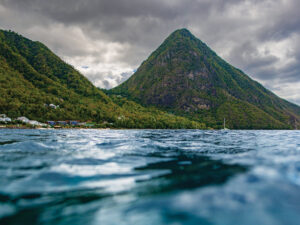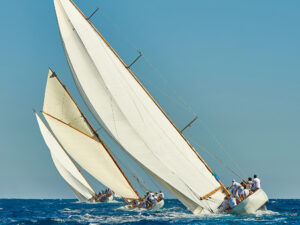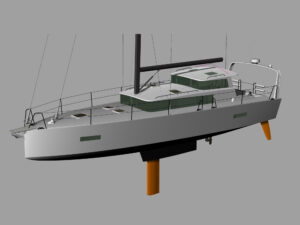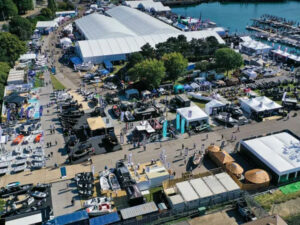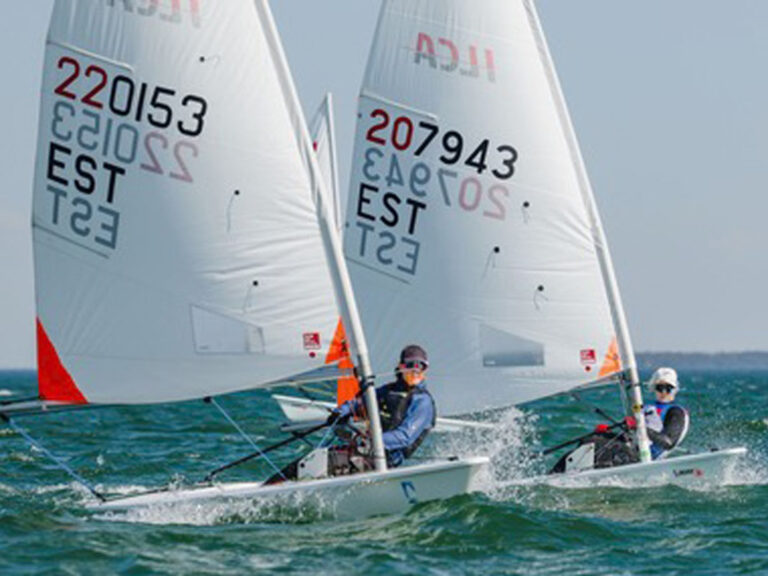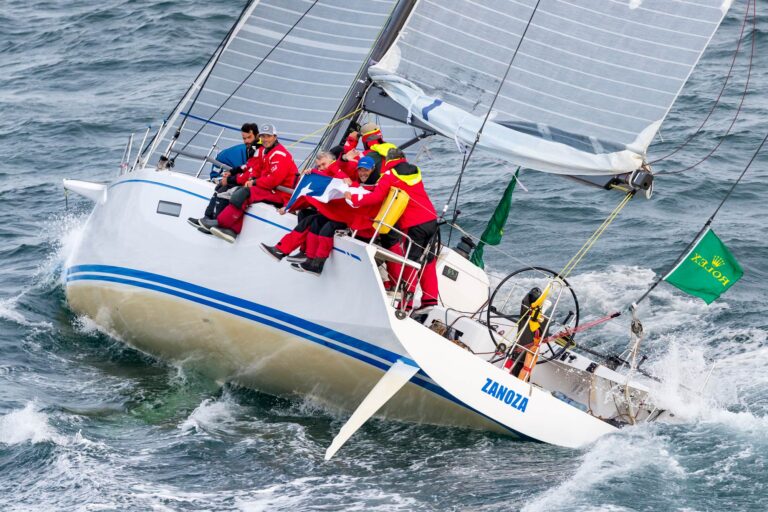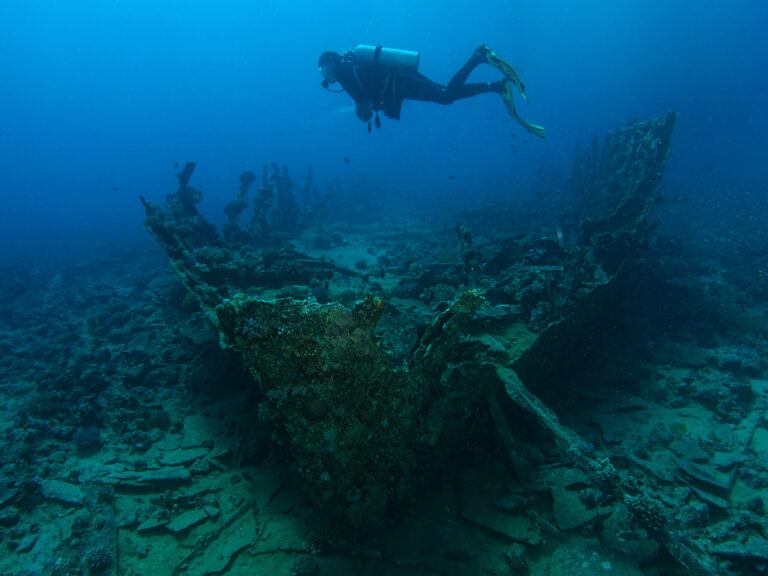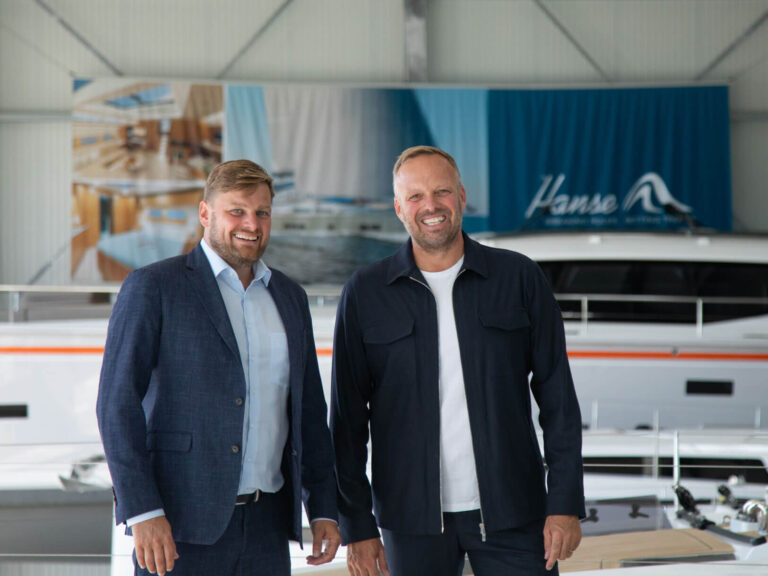
The first time I experienced a fully lit-up, high-performance cruising catamaran was in Hawaii’s Molokai Channel aboard a Gunboat 66. The crew and owners knew how to live. The first mate served a sumptuous lunch as we rocketed along at a close reach under mainsail and a fractional screecher, with the autopilot driving through 5-foot seas. Humpback whales spouted nearby, and 21.7 knots never felt so civilized. § While this experience was eye-opening for me, it was the usual stuff for the owners and crew, who regularly ticked 300-plus-mile days. The boat’s off-the-wind inventory—including the fractional screecher, a masthead screecher, two asymmetrical spinnakers, and a symmetric kite—helped facilitate these big-mile days.
Sailing off-the-wind angles efficiently aboard a multihull requires different sails than a standard main and a self-tacking jib combination. Sailmakers have created a variety of shapes—each optimized for certain wind ranges and windspeeds—to help maximize deeper wind angles. Better still, modern furling and dousing systems help take the sting out of sailhandling, as long as crews are mindful of their sails’ design parameters and their own abilities.
To learn more about today’s off-the-wind sails for cruising multihulls, I reached out to four experts. Phil Berman helped found the Multihull Company brokerage and, in 2013, formed Balance Catamarans, which builds performance-minded cruising cats. Stuart Dahlgren designs and builds sails at UK Sailmakers’ Northwest loft in Sidney, British Columbia. Bob Meagher works as a North Sails’ multihull expert out of the Fort Lauderdale, Florida, loft. Andrew Waters is a sail and service consultant at Quantum’s Annapolis, Maryland, loft.
Below, I share their thinking by starting with sails for close-reaching angles (ballpark 45 degrees) and move abaft through broad-reaching and running angles (theoretically, as deep as 180 degrees). While sailmakers often employ proprietary names for their off-the-wind sails, this article will deal in apparent-wind angles and apparent-wind speeds to describe sails in general terms.
In all cases, the experts stressed that it’s important to have an open and honest dialogue with your sailmaker (before placing your order) about your vessel; its equipment and how it’s rigged; your crew’s experience level; and how, when and where you plan to use your off-the-wind sails. All sails are custom-built, so this conversation can also be a good time to discuss your goals for each sail, and how modern materials, technologies and custom tweaks can help you achieve these ambitions.
Code zeros. When it comes to sailing wind angles from roughly 40 degrees to 110 degrees, few sails are as useful as code zeros. While these sails go by a number of brand names, they are typically paneled sails that fly off sewn-in anti-torsion cables, and that can be loosely defined by their working apparent-wind angles. Code zeros are also typically rigged with dedicated furling drums, which makes for easy sailhandling. Some code zeros are cut flatter and designed for more close-winded work (say, 40 to 70 degrees apparent-wind angle), while others are designed to carry deeper angles (say, roughly 90 to 110 degrees, maybe 120 degrees) and are built with more depth.
“If you’ve got a multihull with a main and a jib, the next sail is a code zero,” Waters says. “It’s versatile enough for reaching in light air, and it’s big enough to cover aft of the beam when the wind is stronger.”
Code zeros can be especially useful for stringing together swaths of light air, and for maximizing angles that a small, high-aspect, self-tacking jib and mainsail combination struggle to efficiently carry.
Waters says that the best way to rig a code zero is by using a bowsprit (longerons can also work well). “An anchor roller is not likely the best place,” he says. “There’s a lot of up-force, so you need something that’s reinforced.”
Ease of use is an important consideration when choosing off-the-wind sails, especially if you sail shorthanded. “The fastest sail doesn’t do any good if it’s stuffed inside a bow locker,” Meagher says. “It needs to be accessible.”
Others agree. “A person of modest experience can easily fly a code zero that’s on a continuous-line furler,” Berman says. “They are fairly easy to operate.”
This ease of use can be partially attributed to the sails’ working apparent-wind angles, however, a lot comes down to the fact that code zeros typically reside on furlers and can be ordered with UV-protective material sewn onto the sail’s leech section. This allows the sails to remain hoisted, genoa-style, even if they aren’t being used. One consideration, of course, is the amount of UV light to which the sail will be exposed (read: Caribbean versus the Pacific “Northwet”) and the amount of time the sail will spend exposed to the elements. “It’s way better to take down the sail if you’re leaving the boat for a long time,” Dahlgren says. “But if you’re on board or on passage, it’s fine to leave it up.”
When it comes to extending the working life of sails with torque cables, Meagher stresses the importance of ensuring that halyards and tack lines are tight. “If the halyard isn’t tight enough, it puts more torque into the system,” he says, adding that he advises cruisers to have the UV-exposed ends of their torque cables inspected every year or so.

Given that code zeros are used typically for reaching angles, jibing isn’t usually a concern. “Reach-to-reach jibes aren’t that common,” Waters says, adding that this would mean rotating through half of a compass card. Instead, he suggests keeping onboard stress levels low by rolling up the sail before jibing.
Asymmetrical spinnakers. As the wind clocks aft, cruisers will encounter a crossover zone where their code zero will stop delivering the same sparkling performance it can produce on closer-winded angles. Depending on one’s crew and vessel, this can be a great time to hoist an asymmetrical spinnaker.
Asymmetrical cruising spinnakers typically are built of various-weight nylon and have soft luffs (unless they are on top-down furlers). They cover apparent-wind angles from roughly 100 to 155 degrees, and apparent-wind speeds up to (ballpark) 15 knots. Like all off-the-wind sails, cruisers can usually order asymmetrical spinnakers optimized for specific angles and windspeeds. Asymmetrical spinnakers usually range from bigger, lighter-weight A1s to A2s and A3s as the wind picks up and clocks astern. Like code zeros, asymmetrical spinnakers are designed to fly off a bowsprit or longeron, however, other options exist for fetching deeper angles (see below).
As mentioned, asymmetrical cruising spinnakers sometimes employ top-down furlers, however, the more common practice is to use a dousing—or snuffing—sock. “Top-down furlers take more rotations to furl a sail than a bottom-up furler,” Meagher says. “So, you want to lead the furling line back to an electric winch.” In this scenario, with a top-down furler, crews would operate the sail much like a furling jib or code zero. (As a word of caution, make sure you are always looking at what you’re affecting when using a powered winch to avoid overstressing equipment.)
In the more common scenario, where the sail has a snuffer, crews typically hoist the sail sausage-style so that it can’t inopportunely inflate. Then, once the halyard has found its sheave box and the boat and crew are ready, a forward hand pulls on a continuous-loop line to pull the sock up to the sail’s head, exposing sailcloth to the breeze. When it’s time to douse, crews simply reverse this process and then lower the sail onto the nets.
“Almost everyone has an asymmetric or symmetric spinnaker in a dousing sock,” Berman says. “Anything that makes sailing easier is better. Always.”
One interesting way to make sailing deeper angles with asymmetrical spinnakers easier involves leveraging the boat’s hulls. “If you’re sailing a deep angle, say 160 degrees, with an asymmetric sail, you could tack it to the windward hull,” Waters says. “This projects more of the sail area around the mainsail.”
Others agree. “Most cruising catamarans have padeyes on the bows for asymmetric spinnakers,” Dahlgren says. “You sometimes need to add a rope clutch for the tack line.”
While racing crews commonly jibe asymmetrical spinnakers (even on multihulls), most cruisers, Waters says, are better off to first furl or douse the spinnaker, jibe their mainsail (and boat), and then redeploy the kite on the new board.
As with all sails, it’s crucial to know when it’s time to downshift to a more conservative sail selection.
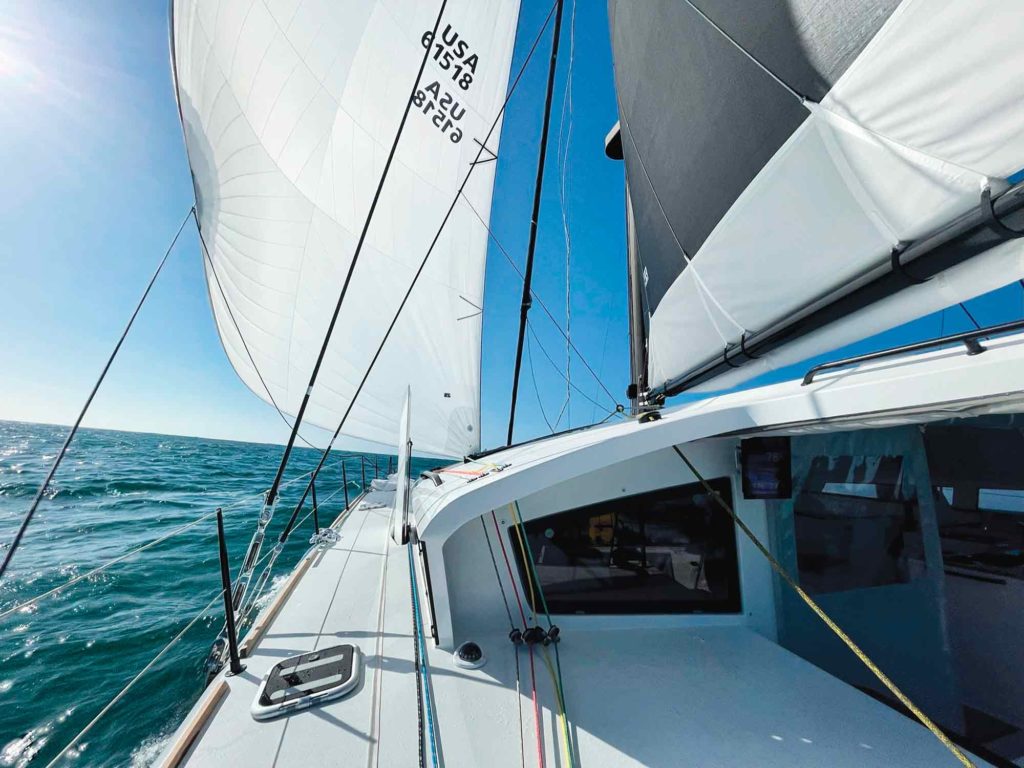
“Off-the-wind sails are for less than 15 knots,” Waters says. “If the winds are higher, the jib comes back. All off-the-wind sails are built with a wind strength and angle in mind, and if you operate the sail outside these parameters, you could have difficulty operating it, or you could damage the sail.”
Because of this, Waters advises sailors to take down the sail anytime they start feeling uncomfortable, or if conditions start exceeding the sail’s design parameters. Meagher agrees, adding that the best time to take down an off-the-wind sail is “10 minutes before you start asking the question.” (This wisdom applies to all spinnakers—asymmetrical and otherwise.)
However, should you miss your 10-minute warning, you can often sail a deep angle (say, 160 degrees) and use your mainsail to blanket the asymmetrical kite for the douse and takedown. Or, Meagher says, if you’re sailing in flat water, you can use the iron jenny.
“It’s magic,” he says. “Turn on the engine, hit the throttles, and your apparent wind just dropped like a rock.” (This trick doesn’t work if you’re pounding into a seaway, as doing so can generate shock loading on the rig and sails.)
Symmetrical spinnakers. As the name implies, symmetrical spinnakers typically have broad-shouldered even-sided cuts that allow them to efficiently sail apparent-wind angles of 130 degrees to 160 degrees (or deeper) in winds up to roughly 10 to 15 knots. Like asymmetrical sails, symmetrical kites are commonly set and doused using socks, and are usually built out of nylon (1.5-ounce cloth is common for offshore use; see sidebar).
“Symmetrical spinnakers are the most stable to fly and the easiest to jibe,” Meagher says, explaining that these can be ideal sails for long downwind runs.
Unlike monohulls that employ spinnaker poles, cruising catamarans typically leverage their beam measurements and twin bows. Dahlgren says that this technique includes a four-line setup, with two guys and two sheets led to bow-fitted padeyes and blocks. Jibing becomes a matter of transferring load from the working guy and sheet to their lazy counterparts as the stern moves through the breeze.
Depending on the apparent-wind angle, the mainsail can sometimes blanket the more efficient spinnaker, which can be less than ideal for passagemaking. While it’s tempting to drop the main and let the kite breathe, it’s important to first talk with your sailmaker and rigger.
“One thing that’s different is that there are no backstays,” Waters says about multihulls, adding that the mainsheet often supports the rig along the length of the mast.
“Some people say that it’s OK to use the topping lift, but that’s not supporting the mast in the center,” Meagher says. “But it’s not a big concern in light air.”
There is the matter of using the mainsail to keep things cool if the wind unexpectedly picks up or shifts direction. Dahlgren says that it’s a good idea to keep the mainsail up, even if it’s reefed: “If you get into trouble with the spinnaker without the mainsail, there’s no way to blanket the kite.”
Given their shape and useful wind angles, symmetrical spinnakers are often critical for racking up offshore miles. “If I could have only four sails, I’d have a symmetric spinnaker, a jib, a screecher and a mainsail,” Berman says. “If the crew is more experienced, they could get a large asymmetric spinnaker. I don’t see people carrying two spinnakers.”
As for properly caring for symmetrical sails, all experts say that the guidelines apply to all of the sails discussed in this article. “Maintenance is often undertaken in the conditions and how the sail is used,” Waters says, referencing each sail’s design parameters. “If you use it outside these parameters, it’s negative maintenance. Pack away sails as dry as possible; if it’s going away wet, dry it at the earliest possible time.”
This is because dry sails rarely develop mildew. However, should this aesthetic and olfactory offense set in, all experts were realistic about the fact that the optics can be “improved” but likely not removed.
Finally, Meagher says, off-the-wind sails that spend significant amounts of time furled and hoisted need to be regularly inspected.
“UV is a killer,” he says, explaining that even a sail that’s protected by Sunbrella or WeatherMax needs to be inspected more often than a genoa that also resides on a furler. “Get it checked every year or year and a half.”
The key—as with so many things sailing-related—is having the right conversations ahead of time, ensuring that you have the right experience, and being judicious about when it’s best to douse or shorten sail. Take these steps, and not only will you reach (bad pun intended) Port B faster, but you’ll also likely have more fun getting there.
David Schmidt is CW’s electronics editor.
String and Things
While sailing involves lots of specialized equipment, cruising sailors can often employ the same running rigging to harness and trim their entire quiver of off-the-wind sails. “Today’s running rigging is lightweight and stretch- and mildew-resistant,” says Tony Rey, an accomplished Grand Prix sailor and a partner at Doyle Sails Newport. “Anything with creep or stretch is because it’s low-quality.” While it can be useful to have a bit of give in the system when sailing off-the-wind angles in a seaway, Rey says it’s best if this comes from the sail, not the sheets or tack line. “It’s more about the material the sail is made from than the running rigging,” he says, advising that cruisers should always check with their rigger beforehand to ensure that their intended cordage can handle the loads. —DS

